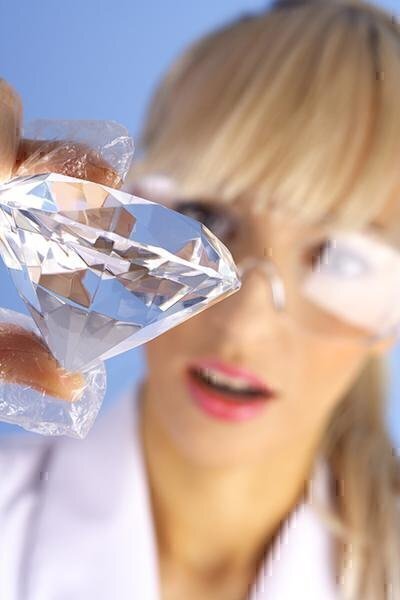Why You Should Buy Lab-Grown Diamonds Instead of Mined Stones
Last updated December 2021
An old-school diamond (the kind that comes from a mine) remains the number one choice for engagement rings in the U.S., and among the most popular stones for other pieces of jewelry. But the times—and the bling people want—may be changing.
When we first published our diamond-buying guide five years ago, only a handful of retailers sold them; now, many do. Earlier this year, Pandora, the world’s largest jewelry retailer, launched its own line of lab-created diamonds and announced it would no longer sell mined ones. Even De Beers, the O.G. of the diamond industry (and still its largest player), now hawks inexpensive manmade stones.
 The diamond-mining industry involves environment-destroying methods; in some parts of the world, the business is fraught with child labor and helps pay for civil wars and to fund violent regimes. Choosing a lab-grown rock assures that your purchase is free of ties to human-rights or natural-resources exploitation.
The diamond-mining industry involves environment-destroying methods; in some parts of the world, the business is fraught with child labor and helps pay for civil wars and to fund violent regimes. Choosing a lab-grown rock assures that your purchase is free of ties to human-rights or natural-resources exploitation.
Manufactured diamonds are actual diamond material (crystallized carbon) and identical to their mined counterparts. The only way to distinguish between the two is via laboratory testing. If you buy one, only you and the seller will know it isn’t “real.” As the GIA’s website states: “Because natural diamonds and man-made diamonds have some of the same physical and other properties, even a skilled jeweler or trained gemologist cannot distinguish them by sight alone.”
The two types of diamonds are so similar that using the term “real” to describe mined ones isn’t fair to manufacturers—doing so would imply lab-grown options are imitations. In the U.S., the Federal Trade Commission prevents sellers from referring to lab-grown diamonds as “synthetic” because other terms (such as “laboratory-grown” or “laboratory-created”) “would more clearly communicate the nature of the stone.”
Although lab-grown diamonds aren’t cheap, they’re still considerably less expensive than mined ones—between the two types, for stones weighing between one and two carats, manufactured stones of similar size and quality often cost 75 percent less than mined ones. Prices are even more reduced for fancy colors, which are rare in nature but comparably easy to grow in a lab.
Because lab stones can possess the same flaws as mined ones, including differences in how they’re cut and polished, you can waste money if you unknowingly buy an inferior product. As with mined diamonds, you can save considerably if you shop around.
Since they cost less and are the same thing, why haven’t labs shut down the diamond mining industry?
One reason is continued stigma surrounding “fakes”—many consumers associate manufactured diamonds with products like cubic zirconia and other poor imitations that attract punchlines.
Consumers are also still hit with marketing that reinforces a lore surrounding mined stones: that “real” diamonds are rare, formed billions of years ago below the Earth’s surface, while manufactured diamonds, on the other hand, were created in a few weeks by engineers in air-conditioned factories. For example, in its comparison of the two types, Helzberg’s website states “the rarity of a natural diamond might be its most appealing characteristic. A finite number of natural diamonds exist in the world, making it a fitting symbol for your one-of-a-kind love.”
Given the diamond mining industry’s horrific history, it seems dubious to conclude that their products have more “romantic” histories than those built in labs.
Plus, mined diamonds aren’t so rare. They were until the late 19th century, when significant deposits were unearthed in Africa, and since then discoveries of large finds have been made in Canada, Russia, and elsewhere. Although diamonds are far more common now, they haven’t become less valuable. That’s because for nearly a century De Beers held a virtual monopoly over the diamond industry and by limiting the supply kept prices stable—and artificially inflated. Although new discoveries have broken De Beers’ monopoly, the new players continue to use its playbook, restricting traffic worldwide to keep supply low and prop up prices.
Another argument often trotted out by mining advocates is that their stones retain their value better than lab-grown stones do. That’s generally true. But there’s not exactly a robust seller’s market for secondhand mined stones, either.
Keep in mind that although lab-grown diamonds are more environmentally sustainable than those from mining operations, an immense amount of energy is required to create lab-grown stones. Earth911.com concludes that the energy used to make lab stones is “consistently found to be half that of mined diamonds. Some companies are working to use renewable energy and capture CO2 from the atmosphere to make their gems, but more need to make this transition to reduce their climate impact.”


